Effective teamwork in Phasmophobia can significantly enhance your ghost-hunting success. This article explores essential roles within a team, strategies for effective communication, and the unique attributes of various ghost types. Understanding these elements will improve your ability to identify ghosts and complete objectives efficiently. By mastering role assignments and adapting strategies, teams can navigate the challenges of ghost investigations more effectively.
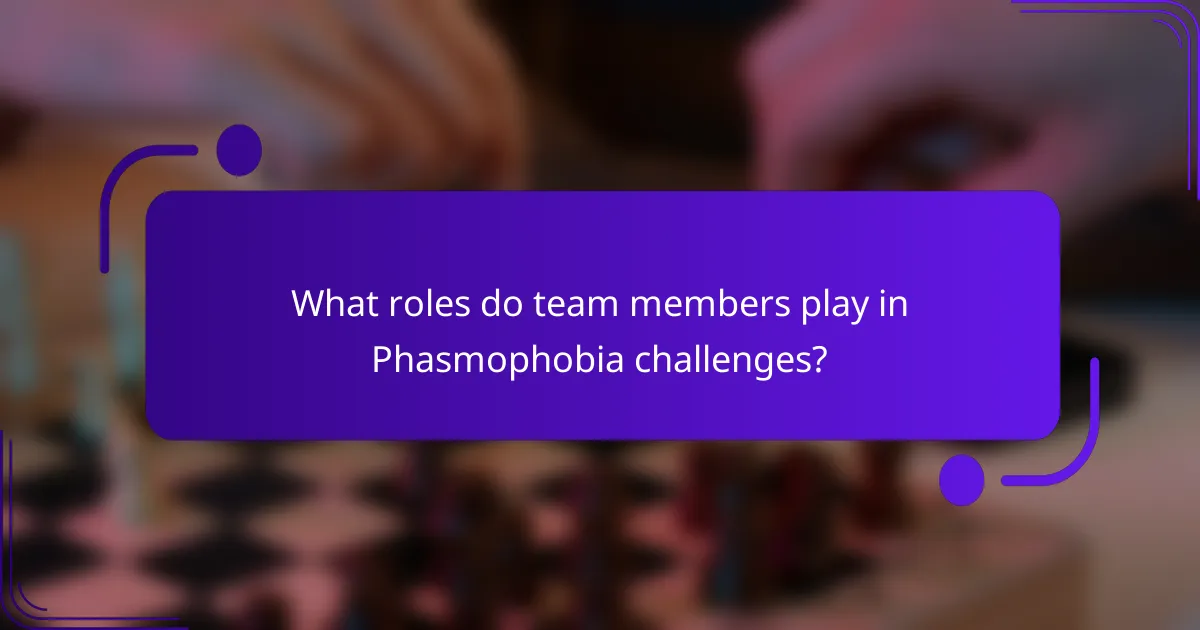
What roles do team members play in Phasmophobia challenges?
In Phasmophobia challenges, team members assume specific roles that enhance gameplay and strategy. Common roles include the investigator, who gathers evidence; the communicator, who relays information; the support, who assists with supplies; and the tracker, who monitors ghost activity. Each role contributes to identifying ghost types effectively and completing objectives efficiently. Team coordination is crucial, as it maximizes strengths and mitigates weaknesses against various ghost types.
How do different roles impact gameplay dynamics?
Different roles significantly impact gameplay dynamics in Phasmophobia by shaping team strategies and interactions. Each role brings unique strengths that influence ghost detection, evidence gathering, and survival tactics. For example, the Ghost Hunter focuses on identifying ghost types, while the Support role aids with equipment management. This division enhances efficiency and minimizes risks during investigations. Effective communication among roles is crucial for adapting strategies based on ghost behavior, leading to successful ghost encounters. Understanding these dynamics helps players optimize their approach, ensuring a cohesive team effort against various ghost types.
Which role is best for beginners?
The best role for beginners in Phasmophobia is the “Support Role.” This role focuses on assisting teammates while learning about ghost types and strategies. Beginners can effectively contribute by carrying essential equipment, such as flashlights and cameras, while observing ghost behavior. This hands-on experience helps build foundational knowledge without overwhelming responsibility. As players gain confidence, they can gradually transition to more active roles, like the “Investigator” or “Team Leader,” which require deeper understanding and decision-making skills.
What are the responsibilities of the Ghost Hunter?
The responsibilities of a Ghost Hunter include investigating paranormal activity, collecting evidence, and ensuring team safety. They analyze ghost types and develop strategies to interact with them effectively. Communication and teamwork are essential for success in these challenges.
How does the role of the Evidence Collector differ?
The Evidence Collector in Phasmophobia focuses on gathering data about ghost activity, while other roles emphasize different strategies. The Evidence Collector prioritizes documenting evidence such as ghost interactions and environmental changes. This role is crucial for identifying ghost types and informing team strategies. Unique to this role is the ability to utilize specific tools like EMF readers and spirit boxes effectively. In contrast, roles like the Team Leader focus on coordinating team actions and ensuring safety during investigations.
What strategies enhance communication among team roles?
Effective communication among team roles in Phasmophobia can be enhanced through clear role definitions, consistent updates, and strategic use of in-game tools. Establishing specific responsibilities helps prevent overlaps and confusion. Regularly sharing information about ghost sightings and evidence fosters collaboration. Utilizing voice chat and in-game features like the spirit box or walkie-talkies ensures timely communication, especially in high-stress situations. Encouraging feedback and open discussions after each game session can also strengthen team dynamics and improve future strategies.
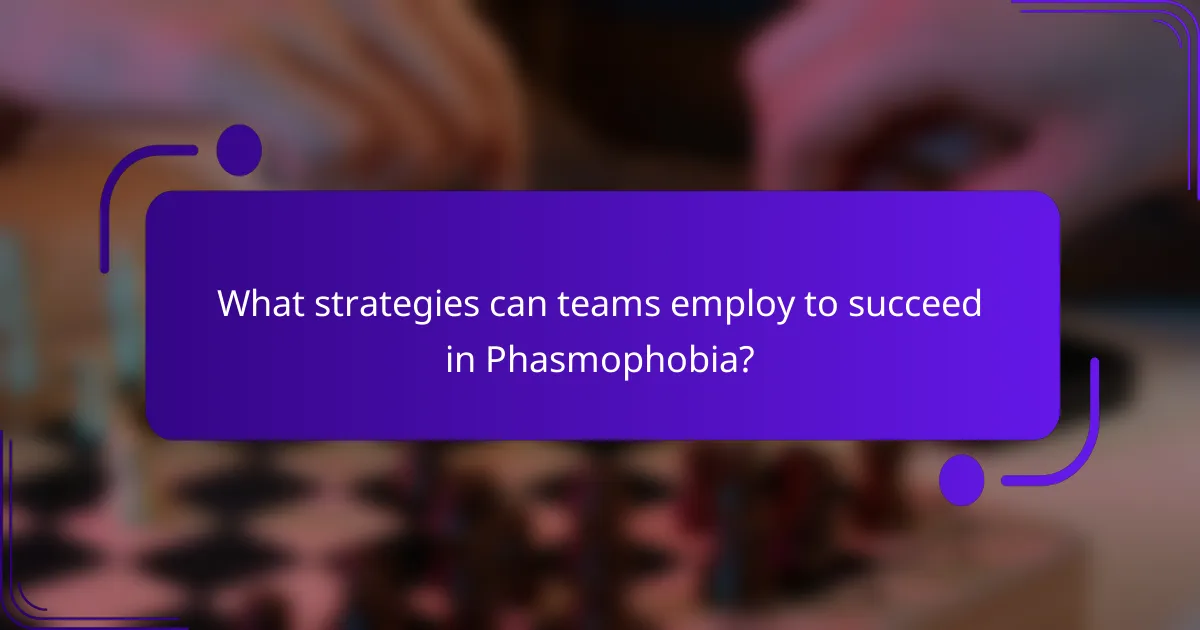
What strategies can teams employ to succeed in Phasmophobia?
Teams can succeed in Phasmophobia by assigning clear roles, communicating effectively, and understanding ghost types. Each member should focus on specific tasks, such as gathering evidence or managing equipment. Effective communication enhances teamwork and ensures everyone is aware of the ghost’s behavior. Familiarity with various ghost types and their unique attributes allows teams to adapt strategies, increasing the likelihood of successful ghost hunts.
How can teams effectively gather evidence?
Teams can effectively gather evidence by coordinating roles, utilizing strategies, and understanding ghost types. Each member should focus on distinct tasks to maximize efficiency. For example, one player can set up equipment while others investigate. Communication is crucial for sharing findings, such as temperature readings or ghost interactions. Using tools like EMF readers and spirit boxes enhances evidence collection. Understanding different ghost types helps tailor strategies, ensuring teams know what signs to look for based on the ghost’s unique attributes.
What are the best tactics for ghost encounters?
The best tactics for ghost encounters in Phasmophobia include teamwork, effective communication, and strategic use of equipment. Assign specific roles such as the investigator, communicator, and support to enhance efficiency. Use tools like EMF readers and spirit boxes strategically to gather evidence while maintaining safety. Prioritize staying in groups to avoid isolation, which can trigger ghost activity. Always have an escape plan in case of aggressive encounters.
How do teams manage fear levels during investigations?
Teams manage fear levels during investigations by fostering communication, assigning roles, and utilizing strategies. Open dialogue allows team members to express concerns. Clearly defined roles help distribute responsibilities, reducing individual stress. Techniques like grounding exercises can also help maintain focus and calm.
Which tools are essential for successful ghost hunting?
Essential tools for successful ghost hunting include EMF meters, spirit boxes, infrared cameras, and digital voice recorders. These tools help detect paranormal activity and communicate with spirits. EMF meters measure electromagnetic fields, indicating potential ghost presence. Spirit boxes facilitate real-time communication by scanning radio frequencies. Infrared cameras capture visual evidence in low light, while digital voice recorders capture audio phenomena. Each tool enhances the investigation process, providing valuable insights into ghostly encounters.
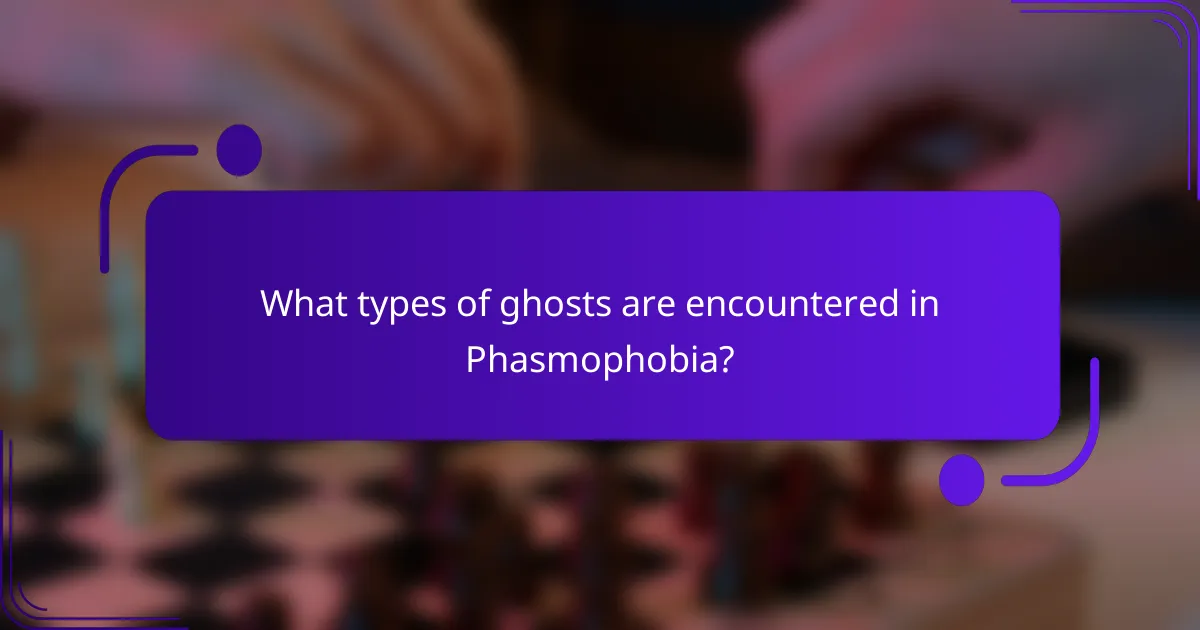
What types of ghosts are encountered in Phasmophobia?
In Phasmophobia, players encounter various ghost types, each with unique attributes. The main categories include Spirit, Wraith, Phantom, Poltergeist, Banshee, Revenant, Shade, Demon, and Yurei. Each ghost type exhibits distinct behaviors and evidence collection methods, influencing team strategies. For example, the Wraith is known for flight and avoiding footprints, while the Poltergeist can throw multiple objects simultaneously. Understanding these ghost types enhances gameplay and team coordination.
How do ghost types influence team strategies?
Ghost types significantly shape team strategies in Phasmophobia by influencing roles and decision-making. Each ghost type possesses unique attributes, such as detection methods and weaknesses, which dictate how teams approach investigations. For instance, some ghosts are more aggressive, requiring players to adopt defensive strategies, while others may be easier to identify, allowing for a more straightforward approach. Understanding these dynamics enhances coordination and improves the chances of successful ghost identification and escape.
What are the characteristics of common ghost types?
Common ghost types in Phasmophobia exhibit distinct characteristics. These include unique hunting patterns, preferences for specific locations, and varied responses to player actions.
| Ghost Type | Unique Attribute | Common Behavior | Evidence Types |
|——————|————————————-|———————————-|—————————|
| Spirit | Can be easily summoned | Non-aggressive, seeks revenge | Spirit Box, EMF Level 5 |
| Wraith | Can teleport | Avoids detection | Freezing Temperatures, Footsteps |
| Phantom | Causes sanity loss when seen | Disappears when photographed | Spirit Box, EMF Level 5 |
| Poltergeist | Can throw multiple objects | Highly interactive | Spirit Box, Fingerprints |
| Banshee | Targets a specific player | Hunts alone | EMF Level 5, Ghost Orbs |
| Revenant | Moves faster when chasing | Slower when not in pursuit | Freezing Temperatures, Ghost Orbs |
Which ghost types present the most challenges?
The most challenging ghost types in Phasmophobia include the Revenant, Shade, and Oni. These entities possess unique traits that complicate team strategies and survival.
The Revenant is fast and relentless, capable of hunting players quickly when they are detected. The Shade exhibits unpredictable behavior, often avoiding interactions unless players are alone. The Oni, while less aggressive, can initiate hunts more frequently, making it essential for teams to remain vigilant.
Understanding these ghost types’ behaviors and attributes is crucial for developing effective strategies to counter their challenges. Teams must adapt their roles and tactics based on the specific ghost encountered to enhance their chances of survival.
How can teams adapt to unique ghost behaviors?
Teams can adapt to unique ghost behaviors by analyzing each ghost’s distinct traits and adjusting their strategies accordingly. Understanding ghost types helps in anticipating actions and forming effective roles within the team. For instance, some ghosts may respond to specific types of evidence, while others may have unique attack patterns. By leveraging these insights, teams can enhance communication and coordination, ultimately improving their chances of survival. Adapting to these behaviors requires flexibility, strategic planning, and a thorough understanding of the ghost’s attributes.
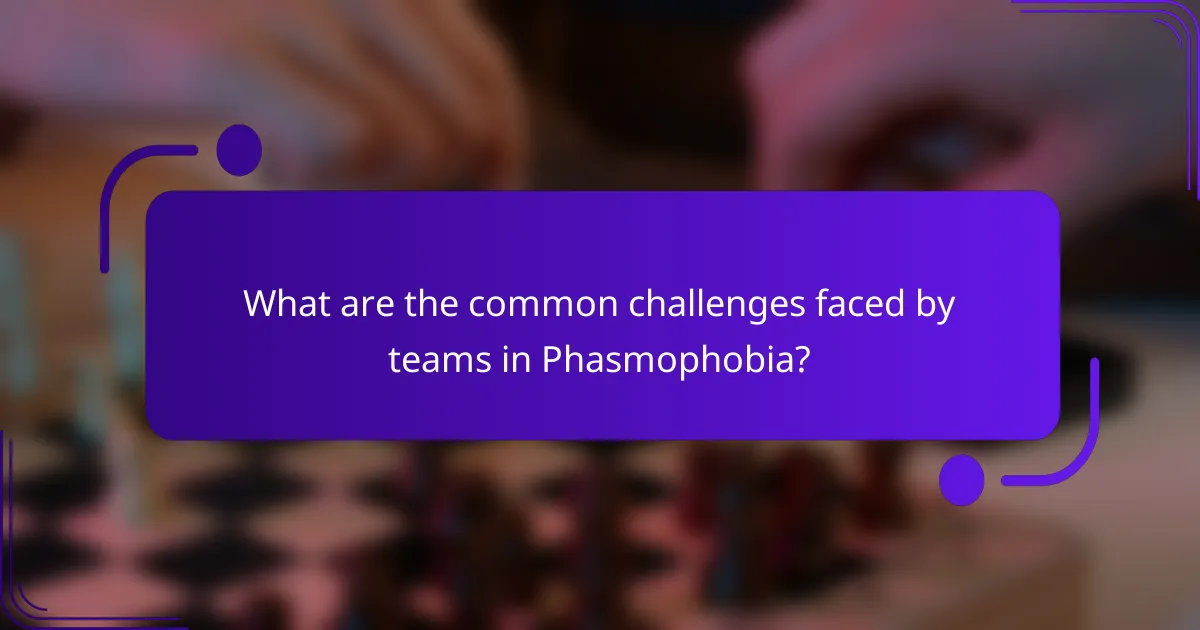
What are the common challenges faced by teams in Phasmophobia?
Teams in Phasmophobia commonly face challenges related to communication, role assignment, ghost identification, and resource management. Effective communication is crucial for coordinating strategies and sharing findings. Miscommunication can lead to errors, such as incorrect ghost identification or poor decision-making. Role assignment is essential, as each team member must understand their responsibilities, whether as a researcher, support, or equipment handler. Ghost identification is complex due to the variety of ghost types, each with unique traits and behaviors. Lastly, managing limited resources, such as sanity levels and equipment, is vital for team survival and success in investigations.
How does teamwork affect the success of ghost hunts?
Teamwork significantly enhances the success of ghost hunts by fostering effective communication, role distribution, and strategic planning. Each team member’s unique skills contribute to identifying ghost types and executing strategies effectively. For instance, a dedicated evidence collector can focus on gathering data while a communicator interacts with the spirit, optimizing the overall hunt. This collaborative approach increases the likelihood of success, as diverse perspectives lead to comprehensive investigations. In Phasmophobia, understanding various ghost types further emphasizes the need for teamwork, as different ghosts require distinct strategies for successful identification and containment.
What are the psychological challenges of ghost hunting?
Ghost hunting presents psychological challenges, including fear, anxiety, and group dynamics. Team members may experience heightened phobias, such as phasmophobia, affecting decision-making. Effective strategies involve clear roles and communication to manage stress. Understanding various ghost types can also alleviate misconceptions and fears, enhancing the team’s focus and cohesion.
How do environmental factors impact team performance?
Environmental factors significantly influence team performance in Phasmophobia by affecting communication, strategy execution, and adaptability to ghost types. Teams must navigate diverse environments, such as haunted locations, which can enhance or hinder their effectiveness. For example, poor visibility or sound distractions can lead to miscommunication and mistakes. Additionally, the psychological impact of fear can alter team dynamics, making effective roles and strategies essential for success. Understanding these factors enables teams to optimize their approach, ensuring better coordination and ghost identification.
What strategies can mitigate common challenges?
To mitigate common challenges in Phasmophobia, teams should adopt clear roles, communication strategies, and effective ghost identification techniques. Assigning specific responsibilities, such as a lead investigator or a support role, enhances efficiency. Establishing communication protocols ensures vital information is shared promptly. Using tools like the spirit box or EMF reader effectively aids in identifying ghost types, reducing uncertainty and improving team coordination.
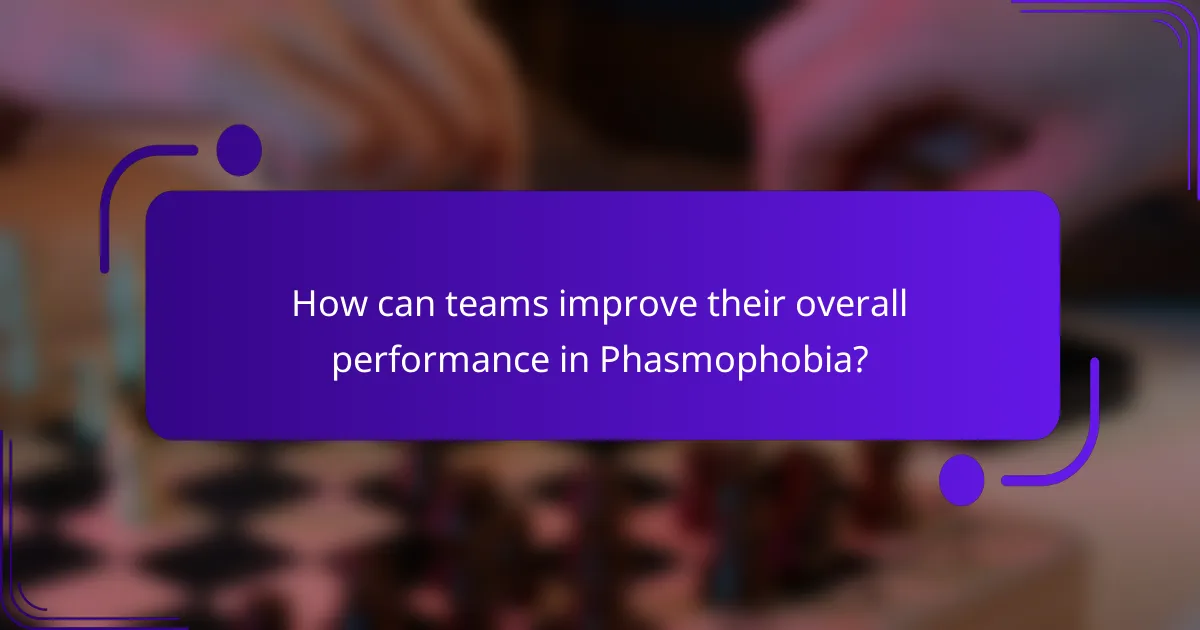
How can teams improve their overall performance in Phasmophobia?
Teams can improve their overall performance in Phasmophobia by clearly defining roles, developing effective strategies, and understanding different ghost types. Assigning specific responsibilities enhances coordination and efficiency. For example, a designated ghost hunter focuses on tracking the entity, while a support player manages equipment and communication.
Utilizing strategies such as teamwork during investigations and sharing information about ghost behavior can lead to quicker identification and successful exorcisms. Familiarity with ghost types enables teams to adapt their approach based on the unique attributes of each entity, such as the specific evidence required for identification.
Regular practice and communication among team members can also significantly boost performance, allowing for smoother operations and better decision-making during high-pressure situations.
What are best practices for effective team coordination?
Effective team coordination in Phasmophobia involves clear role assignments, strategic communication, and understanding ghost types. Each team member should have a defined role, such as a scout, support, or evidence collector, to streamline actions. Regularly communicate findings and strategies during gameplay to adapt to challenges. Familiarity with ghost types enhances decision-making, as each type has unique behaviors and weaknesses. This knowledge allows teams to develop targeted strategies, improving overall effectiveness in ghost hunting.
How can players enhance their individual skills?
Players can enhance their individual skills in Phasmophobia by focusing on specific roles, practicing strategies, and understanding ghost types. Mastering each role, such as the investigator or the support, allows players to contribute effectively to team challenges. Regular practice improves familiarity with equipment and enhances decision-making under pressure. Understanding ghost types, their behaviors, and weaknesses enables players to adapt their strategies, increasing survival chances and successful ghost identification.
What common mistakes should teams avoid?
Teams should avoid poor communication, neglecting roles, and failing to adapt strategies. Misunderstandings can lead to inadequate responses to ghost types. Assigning clear roles enhances coordination, while flexible strategies improve survival chances. Regularly reassessing team tactics can prevent common pitfalls in Phasmophobia.
How do experienced players recommend approaching challenges?
Experienced players recommend a collaborative approach, emphasizing clear communication, defined roles, and strategic planning. Assign roles based on strengths, such as a designated ghost hunter, equipment manager, and lookout. Utilize tools effectively, like EMF readers and spirit boxes, to gather evidence. Understanding ghost types and their behaviors enhances strategy, allowing teams to anticipate challenges. Prioritize objectives and adapt to evolving scenarios, ensuring everyone remains focused and informed throughout the investigation.